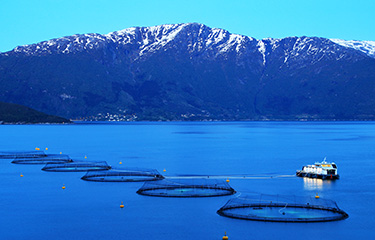The government of Norway has proposed a new resource rent tax on aquaculture, with effect from 1 January, 2023, which will affect producers of salmon, trout, and rainbow trout.
The tax is expected to generate proceeds of between NOK 3.65 billion and NOK 3.8 billion (USD 347 million and USD 361.2 million, EUR 355.6 million and EUR 370.2 million) annually. According to the plan, which would need to be approved by parliament, half of the revenues collected will go to public funds.
The proposal was sent out for consultation on 28 September. Following its return, the government will bring the legislation to the Storting (supreme legislature of Norway) to enable the proposed rules to apply from the 2023 tax year.
Norway’s publicly traded salmon farming firms all saw their share prices tumble in trading on Wednesday, 28 September, with Mowi, Lerøy Seafood, and SalMar’s stock prices falling between 15 and 19 percent. According to Reuters, while Norway has a USD 1.2 trillion (EUR 1.2 trillion) sovereign wealth fund, the tax increases are necessary to curb inflation.
"The board and management in Lerøy Seafood Group are in the process of assessing the proposal but do not have a complete overview yet," Lerøy Seafood said in a statement. "However, the proposal is undoubtedly hostile to the industry. If approved, it will have a strong negative impact on the entire industry, unless decision makers at the Storting and people along coastal Norway manage to stop the proposal following the ongoing consultation period."
Announcing the move, which also includes tax increases on energy generation, the government stated that its bureau Statistics Norway has identified substantial resource rent – or profits after all costs had been accounted for – in the aquaculture industry over several years. It said that resource rent in aquaculture has risen strongly since 2012 and, for the period 2016 to 2018, totaled just over NOK 20 billion (USD 1.9 billion, EUR 1.9 billion).
The aquaculture sector’s resource rent for 2021 is estimated at NOK 11.8 billion (USD 1.1 billion, EUR 1.1 billion), according to the government, which said it expected the industry to share of the extraordinary return generated through the exploitation of the marine resources it uses.
“The proposal covers the production of salmon, trout, and rainbow trout and involves the taxation of resource rent at an effective rate of 40 percent. The rules are formulated in such a way that only the largest operators will pay resource rent tax. This is done by granting a tax-free allowance of between 4,000 and 5,000 metric tons,” Norway’s Finance Ministry said in a statement. “A key element of the proposal is that the local communities which make natural resources available should be guaranteed a share of the resource rent. The tax revenues are estimated to be between NOK 3.65 and 3.8 billion and the government is planning for half of this to go to the municipal sector.”
The ministry has calculated the proposed tax-free allowance of between 4,000 and 5,000 MT is equivalent to NOK 54 million and NOK 67.5 million (USD 5.1 million and USD 6.4 million, EUR 5.3 million and EUR 6.6 million). Around 65 to 70 percent of aquaculture companies have collected biomass under licenses of less than 4,000 and 5,000 MT of maximum permitted biomass, it said.
The government said development licenses – used to test new technology – are not covered by the resource rent tax, but that if they are converted to ordinary licences for fish for consumption, they will be covered by the resource rent tax from the date of conversion.
The proposed tax rules grant tax-free allowances in the form of estimated average profit per ton of biomass, which can be deducted from positive resource rent income. Corporate tax will be calculated before resource rent tax on aquaculture, and resource rent-related corporate tax will then be deducted from firms’ basis for resource rent tax.
Photo courtesy of Terje Aase/Shutterstock







